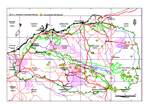Click on images
to enlarge



Photographer: S. van Leeuwen

Photographer: B.R. Maslin

Photographer: B.R. Maslin

Photographer: J. Simmons
, Hamersley Ra, BRM 16 July 2000, ORIGINAL SCAN, ADJUSTED RICHARD WOODMAN_sml.jpg)
Photographer: B.R. Maslin
 3, BRM 8646, ADJUSTED RICHARD WOODMAN_sml.jpg)
Photographer: B.R. Maslin
, BRM 8646, lab photo by Fiona McCallum ADJUSTED_sml.jpg)
Seed from one herbarium voucher. Scale in mm. Photographer: F. McCallum.
Botanical name
Acacia hilliana Maiden in A.J.Ewart & O.B.Davies, Fl. N. Territory 340, pl. 27, figs A-D (1917)
Common name
Hill's Tabletop Wattle (preferred common name), Sandhill Wattle and Hilltop Wattle
Aboriginal name
Bundaljingu (Banyjima) and Puntanungu (Nyangumarta)
Description
Low, sprawling, semi-prostrate, normally flat-topped, horizontally-branched, resinous, glabrous shrubs 0.3-1 (-1.5) m tall and spreading 1-3 (-4-5) m across. Branchlets variably tuberculate, obscurely ribbed. New shoots bright green, slightly to very sticky and aromatic (with a resinous or sometimes a delicate citrus odour). Phyllodes solitary at nodes or sometimes in clusters of 2 or 3, terete to compressed, 2-6 (-7) cm long, about 1 mm in diameter, rather wide-spreading, commonly shallowly to moderately curved upwards (often curving from near the base), sometimes straight, green to grey-green, sub-glaucous or glaucous, usually sparsely tuberculate; parallel longitudinal nerves numerous and very obscure; the apex acute but not spiny. Inflorescences simple; peduncles 10-30 (-40) mm long; spikes erect, (10-) 20-45 mm long, golden. Flowers 5-merous; sepals united for ¼-1/3 their length. Pods linear but broadest at the top and narrowed towards the base, flat but thick, 2-8 cm long, 2.5-5 (-6) mm wide, erect, woody, opening elastically from apex, very sticky resinous and fragrant like citronella or lemon grass (at least when young), longitudinally obliquely nerved, dark brown, ±hooked at apex; margins thick and pale coloured. Seeds oblique to almost longitudinal in pods and seated in pronounced depressions, not readily shed following pod dehiscence, obloid-ellipsoid, 3-5.5 mm long, dull to slightly shiny, brown; pleurogram bordered by pale-coloured tissue; the funicle-aril pale coloured, straight and narrowly conical.
Characteristic features
Low, sprawling, normally flat-topped, glabrous shrubs. Young growth sticky resinous. Phyllodes ±terete, relatively short (mostly 2-6 cm), commonly curved upwards, obscurely longitudinally nerved. Spikes long (mostly 20-45 mm) and erect, on long peduncles (mostly 10-30). Pods erect, very sticky resinous and fragrant like citronella or lemon grass (especially when young), linear but narrowed towards the base, woody, flat with thickened margins. Funicle-aril straight and narrowly conical.
Distribution and ecology
Widespread and quite common in northern and central Australia (between about 17 degrees S and 25 degrees S) where it extends from the Pilbara region of Western Australia eastwards through Northern Territory and may possible reach far northwestern Queensland. It has a scattered distribution throughout much of the Pilbara, often forming localized colonies in the areas where it occurs. Over its geographic range A. hilliana grows in a variety of habitats ranging from skeletal red loamy sand or sand over laterite, quartzite or ironstone hills and on spinifex plains in deep sand. In the Pilbara it is often, but not always, found on rocky sites, mostly high in the landscape growing in skeletal soils with a surface mantle of pebbles.
Flowering and fruiting period
Pilbara plants have been collected with at least some flowers present between April and November but the main flowering flush is in May and June. The fruiting period probably extends from September to November but Pilbara specimens with mature seeds have been collected in only October.
Variation
Acacia hilliana is a relatively invariate species. However, a few Pilbara specimens are slightly atypical in that they lack the small tubercles which are normally scattered over the phyllodes and branchlets.
Affinities
Related to the Pilbara endemic species A. arrecta , which has similar growth form, phyllodes and pods; these two species sometimes grow together. Acacia arrecta is most readily distinguished from A. hilliana by its flowers which are arranged in globular heads (not cylindrical spikes) and its pods which do not have thickened margins.
The species appears to hybridize with A. stellaticeps in the extreme north west of the Pilbara (see A. hilliana x stellaticeps).
Notes
Horticulturally this species has good potential as a ground cover. It is very attractive when in flower due to proliferation of long, erect spikes that project beyond the normally flat-topped crown; similarly, the pods are erect and when young are sticky resinous with a delicate aromatic odour.
Used widely in the Pilbara land rehabilitation industry, especially on mine sites in the Hamersley Range.
Pilu (Banyjima) or makuya (Kariyarra) (edible grubs) can be recovered from the roots of A. hilliana.
Conservation status
Not considered rare or endangered.
Origin of name
This species was named for Gerald Freer Hill whose Northern Territory specimens that were collected in 1911 were used by Joseph Henry Maiden (1917) to prepare the original description of this species. Hall (1978) provides biographical details on Hill.
References
Hall, N. (1978). Botanists of the Eucalypts. pp. 180. (CSIRO: Melbourne.)
Maiden, J.H. (1917). Notes on Acacia, No. 3 - Extra-Tropical Western Australia. With descriptions of new species. Journal and Proceedings of the Royal Society of New South Wales 51: 238-274.
